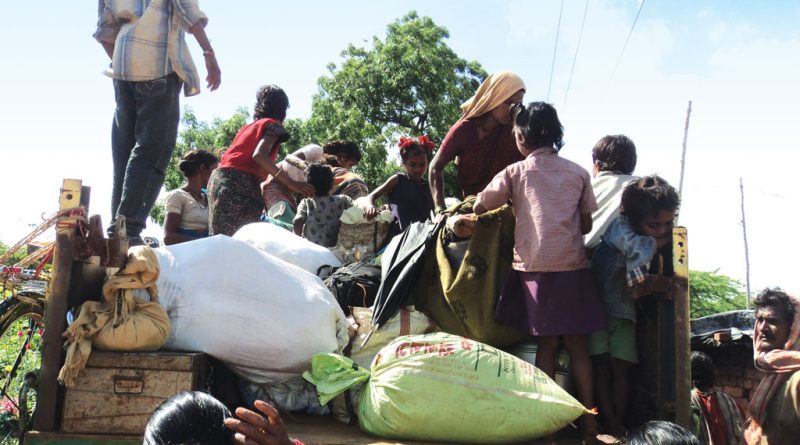CHALLENGE OF RETAINING FARMERS ON THE FARM

-Pandurang Hegde –
The FAO estimates that about 763 million people move within their own courtiers due to hunger, poverty and the increase in extreme weather-related events linked to climate change is forcing farmers to migrate in search of better livelihood opportunities. Almost a third of India’s population, over 300 million is migrants.
The Census of India reports that about 84 percent migrate within the state and about 2 percent are intra–state migrants. Huge numbers from the Eastern regions and North East areas have moved to different parts of India in search of work and better employment opportunities. Most of them are seasonal migrants, working for a short time and returning to their original state to fend off the small farms they own.
According to the National Sample Survey Organization, 45 percent of the farmers interviewed wanted to quit farming. There are multiple factors, especially declining productivity and profitability that act as a disincentive for the younger generation forcing them to migrate.
FAO has called for creating conditions that allow rural youth to stay at home by providing resilient livelihoods to tackle the migration challenge. Creating business opportunities that are noncrop based, in food processing and horticultural enterprises can lead to increased food security. There is an urgent need to build sustainable growth based on the long-term recovery of the rural community.
The National Commission of Farmers called for attracting and retaining educated youth in the farming sector. Heeding to this advice the National Policy for Farmers adopted by Parliament in 2007 emphasized the need to involve youth in agriculture by providing appropriate support measures to retain them in agriculture and allied ancillary processing industries.
Since 2014 NDA led government at the centre has launched several initiatives to address this crisis. The flagship programs like Soil Health Card, Pradhan Mantri Fasal Bima Yojana, Rashtirya Krishi Vikas Yojana etc are some of the schemes providing support to farming community. Each of these programmes attempts to provide solutions to reduce and mitigate the crisis, either of climate change or failure of crops due to lack of rainfall.
The government has set the ambitious target of doubling the farmer’s income by 2022, when the country completes 75 years of independence. Towards achieving this target, the government is reorienting interventions in the farm and non-farm sectors.
The most unique initiative is ARYA or Attracting and Retaining Youth in Agriculture. Launched by Indian Council of Agricultural Research it aims at attracting and retaining youth in rural areas by providing sustainable income through value addition and establishing market linkages to make it attractive for the younger generation to return to villages. This is being implemented in 25 states through Krishi Vigyan Kendra, in one district of each state. It attempts to showcase a working model that is economically feasible for the youth and which has the potential to attract them.
While launching ARYA, Prof M S Swaminathan said “”Unless agriculture is made remunerative and attractive, it would be difficult to retain youth in the field,” he said. When even existing farmers are moving away from farming, unless agriculture is made remunerative, it is unlikely that educated youngsters would take it up. Unless productivity or income is increased, farming cannot become an attractive venture for the young”.
Another initiative as part of the Skill India programme is supporting Agriculture Skill Council of India. The main objective is to build the capacity of the agricultural sector and bridge the gap between the labs and farms. It is being done through upgrading the skills of cultivators, agricultural labours and those engaged allied industry supporting agricultural activities.
It should be hoped that these schemes would attract youth to farming once again. Otherwise, we have reached a situation when majority of youth, even those belonging to farming families, do not want to pursue the farming as their vocation. They have experienced the harshness of the life of a farmer, where all his efforts to earn a decent income after putting in hard labour produces meagre income or total loss during the time of drought, leaving behind the burden to debt.
The recent initiatives by the government and also the recent leaf forging of technological innovations can help them to resolve the technical crisis and establish a direct linkage with the consumer providing assured income. In this context, Centre’s initiative eNAM (National Agriculture Market) launched in 2016 is very significant. It is a pan India electronic trading portal which networks the existing Agricultural Produce Marketing Committee (APMC) mandis to create a unified national market for agricultural commodities.
With 25 per cent of the country’s population between 18-29 years, it has great potential to entice youth towards farm sector. Farming offers young generation a chance to make a difference by growing food to meet the hunger needs of the countrymen. The government should identify such successful young farmers and provide media and policy support to entice youth with the grand mission of feeding the millions with safe and nutritious food.
Under these circumstances we need multiple strategies that enhance the status of the young farmer to retain on the farm. Like the slogan JAI JAWAN, JAI KISAN, we need to coin the slogan that farmer is also a soldier of Mother Earth protecting our soils and feeding the countrymen.

